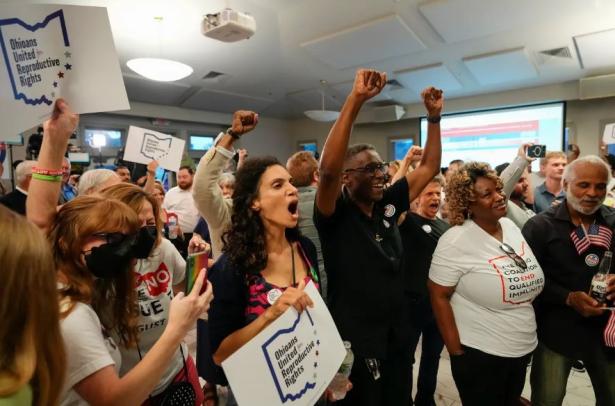Ohioans have overwhelmingly rejected a proposal to make it more difficult for citizens to amend the constitution, the Associated Press has projected.
The only item on voters’ ballots Tuesday was Issue 1, a Republican-led, legislature-initiated amendment to Ohio’s constitution that would raise the threshold for future constitutional amendments to become law. Nearly 700,000 Ohioans voted early, and many more were expected to descend on polling locations to decide whether it is time to change a 111-year-old provision of the state’s main governing document.
Issue 1 would have raised the bar for constitutional amendments to pass to 60%, instead of a simple majority. It also would have enacted stricter signature requirements to put citizen-initiated amendments on the ballot in the first place; petitioners would have had to gather signatures from 5% of voters in each of Ohio’s 88 counties, a steep jump from the present 44-county requirement.
Issue 1 also eliminated a 10-day cure period petitioners have to gather more signatures if they failed to meet the signature requirement.
Shortly after 8 p.m., opponents of Issue 1, including Ohio AFL-CIO, Innovation Ohio, the Ohio Democratic Party and the Ohio Senate Democratic Caucus, began declaring victory.
“The defeat of Issue 1 will go down in history as a victory for our state and democracy,” Senate Minority Leader Nickie Antonio said in a statement. “Ohioans saw through the despicable attempt to silence voters and chose to preserve majority rule.”
Just before 9:45 p.m., Ohio House Speaker Jason Stephens (R-Kitts Hill) acknowledged Issue 1’s defeat — while looking toward the abortion rights vote in November.
“The people of Ohio have spoken. It is now time to turn our attention to November,” Stephens said in a statement. “As a 100% pro-life conservative, we must defeat Issue 1 on November 7 to stop abortion from being a part of our state’s constitution.”
In a statement, Tim Burga, president of the Ohio AFL-CIO, reflected on the hasty process that brought Issue 1 to voters’ ballots less than 90 days before the election.
“For the entirety of this year, politicians supporting Issue 1 ignored the will of the people in the legislative process, flip-flopped on their ruling not to hold August special elections, costing tax-payers millions of dollars, and spread misinformation and lies from start to finish,” Burga said. “In the end, voters would not be fooled by this unprecedented, corrupt attempt to silence our voice.”
Ohio Senate President Matt Huffman, in a statement and before the press Tuesday night, also looked to the tight turnaround — as a detriment to Issue 1.
“This was a heavy lift and we needed ‘all hands-on deck,’ which disappointingly we didn’t have,” Huffman said in a statement.
Why did we hold a special election?
The vast majority of Ohioans weren’t supposed to have things to vote on in August.
The General Assembly passed sweeping voting reform legislation last December that implemented a new photo identification law and eliminated most August special elections. The elimination of August special elections was a bipartisan reform and was supported by county boards of elections due to high costs, high workloads and low turnout.
But in May, Republican state legislators, with the blessing of Secretary of State Frank LaRose, voted to hold an August special election for Issue 1.
“Attempting to amend Ohio’s Constitution is a lucrative business, and monied interests see Ohio as an easy mark,” Ohio State Rep. Brian Stewart (R-Ashville) said when the House voted. “Enough’s enough.”
The election cycle has proven to be an intense one, with both supporters and opponents raking in millions of dollars in funding, mostly from out of state. Many of those dollars have gone to aggressively run campaign advertisements.
Who voted yes?
Supporters of Issue 1, including LaRose and other Republican elected officials, argued that requiring a supermajority to pass amendments would have protected the constitution from undue, outside influence. The 88-county requirement, supporters contended, ensured that only widely bipartisan provisions are added.
Issue 1 was endorsed by the Ohio Right to Life, Ohio Chamber of Commerce, Buckeye Firearms Association, Ohio Farm Bureau and Ohio Restaurant Association, among other organizations.
The not-so-unspoken reason behind the Republican push to get Issue 1 on the ballot – and into the constitution – is that it would have made it more difficult for an impending abortion rights amendment to pass. The amendment, which would protect the right to abortion up until fetal viability and for the health and safety of the pregnant person, was certified in late July to be voted on in November.
LaRose told voters in June that Issue 1 was “100% about keeping a radical, pro-abortion amendment out of our constitution.”
With the defeat of Issue 1, the abortion rights amendment’s path to becoming law has become a bit clearer. The amendment’s fate, however, is pending an Ohio Supreme Court decision on whether the language of the amendment follows necessary requirements.
Who voted no?
Opponents of Issue 1, including Democratic lawmakers, abortion rights groups, voting rights organizations and former Republican state officials, repeatedly called Issue 1 “unnecessary, unfair and undemocratic.”
Organizations that opposed Issue 1 include the League of Women Voters of Ohio, Rank the Vote Ohio, Protect Choice Ohio, the ACLU of Ohio and Ohio’s Fraternal Order of Police.
House Minority Leader Allison Russo described the initiative as a power-grab by conservative lawmakers to further cement their supermajority across Ohio’s three branches of government. To opponents, the citizen-initiated amendment process serves as a referendum on politicians who ignore the will of voters.
Issue 1 opponents and abortion rights advocates argue the will of voters is to enshrine abortion rights in Ohio’s constitution. A slate of polls supports that assertion, with anywhere from 54% to 58% of Ohio voters supporting the abortion rights amendment.


Spread the word